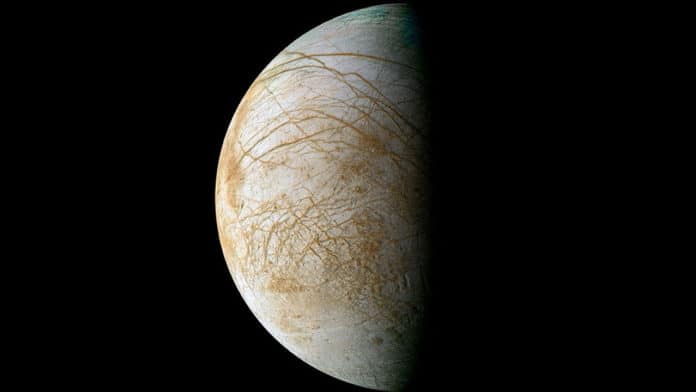Europa is perhaps the largest moon in the solar system. Since the flybys of the Voyager and Galileo shuttle, scientists have held that the surface covering skims on a subsurface ocean. Anyway, the origin and structure of this ocean have been indistinct.
The scientists, based at NASA‘s Jet Propulsion Laboratory in California, modeled geochemical reservoirs within the interior of Europa using data from the Galileo mission.
Their new model supports the theory that the interior ocean in Jupiter‘s moon Europa could be habitable. Also, they have calculated that this water, believed to be an ocean under the surface ice shell, could have been formed by the breakdown of water-containing minerals due to either tidal forces or radioactive decay.
Lead researcher Mohit Melwani Daswani said, “We were able to model the composition and physical properties of the core, silicate layer, and ocean. We find that different minerals lose water and volatiles at different depths and temperatures. We added up these volatiles that is estimated to have been lost from the interior. We found that they are consistent with the current ocean’s predicted mass, meaning that they are probably present in the ocean.”
Scientists found that the ocean worlds such as Europa can be formed by metamorphism. Metamorphism is the change of minerals or geologic texture in pre-existing rocks, without the protolith melting into liquid magma. The change occurs primarily due to heat, pressure, and the introduction of chemically active fluids.
According to scientists, heating and increased pressure caused by early radioactive decay or later subsurface tidal movement, would cause the breakdown of water-containing minerals, and the release of the trapped water.
What’s more, scientists also found that the ocean would originally have been mildly acidic, with high concentrations of carbon dioxide, calcium, and sulfate.
Mohit Melwani Daswani said, “Indeed it was thought that this ocean could still be rather sulfuric, but our simulations, coupled with data from the Hubble Space Telescope, showing chloride on Europa’s surface, suggests that the water most likely became chloride rich. In other words, its composition became more like oceans on Earth. We believe that this ocean could be quite habitable for life.”
“Europa is one of our best chances of finding life in our solar system. NASA’s Europa Clipper mission will launch in the next few years, and so our work aims to prepare for the mission, which will investigate Europa’s habitability. Our models lead us to think that the oceans in other moons, such as Europa’s neighbor Ganymede, and Saturn’s moon Titan, may also have formed by similar processes. We still need to understand several points, though, such as how fluids migrate through Europa’s rocky interior.”
Professor Steve Mojzsis, Professor of Geology at the University of Colorado, said, “A long-standing question over whether a “cloaked ocean” world like Europa could be habitable boils down to whether it can sustain a flow of electrons which might provide the energy to power life. What remains unclear is whether such icy moons could ever generate enough heat to melt rock; certainly, interesting chemistry takes place within these bodies, but what reliable flow of electrons could be used by alien life to power itself in the cold, dark depths?”
“A key aspect that makes a world “habitable” is an intrinsic ability to maintain these chemical disequilibria. Arguably, icy moons lack this ability, so this needs to be tested on any future mission to Europa.”
Now, scientists are working in collaboration with groups in Nantes and Prague to try to identify if seafloor volcanoes may have contributed to the evolution of the chloride-rich water on Europa. NASA has recently released new high-resolution photos of Europa, showing possible exploration sites to test these findings.
This work, which is not yet peer-reviewed, is presented for the first time at the virtual Goldschmidt conference, and may have implications for other moons in the Solar System.
